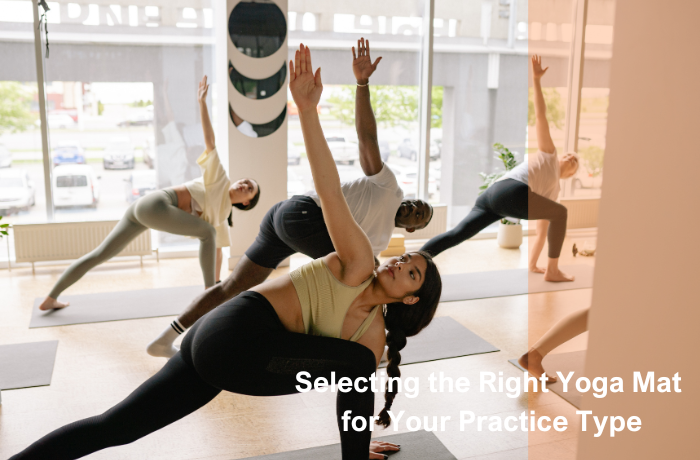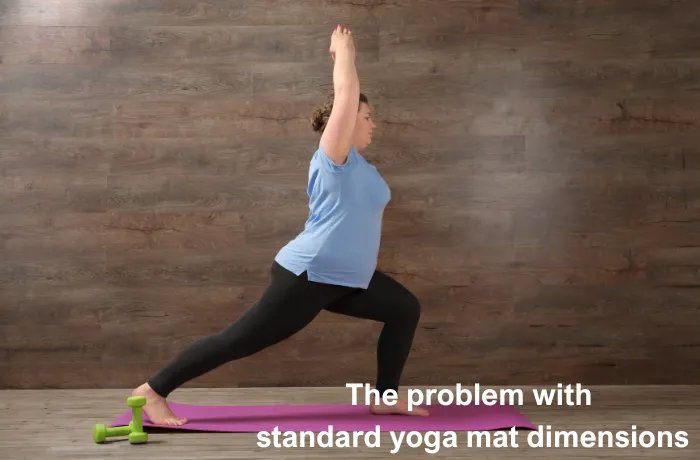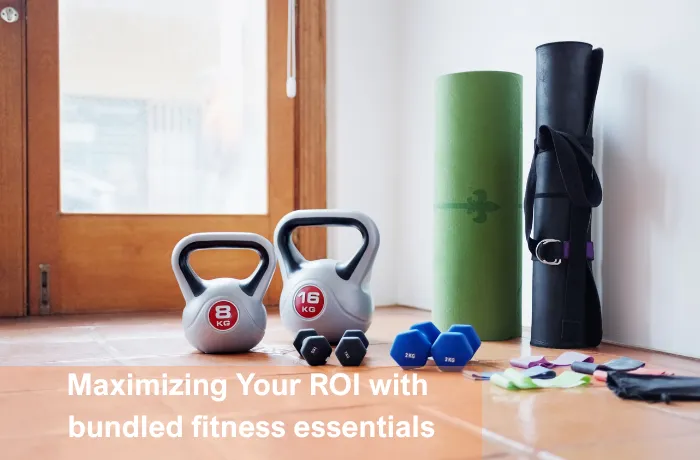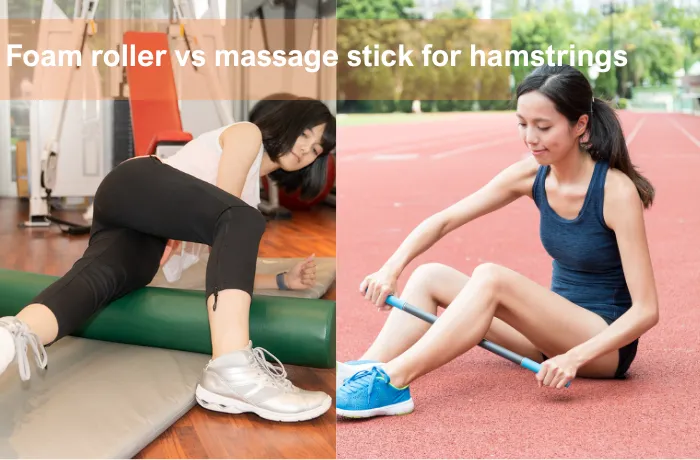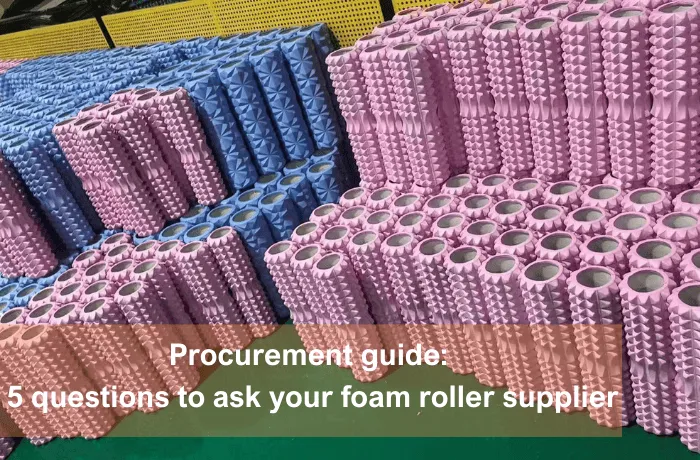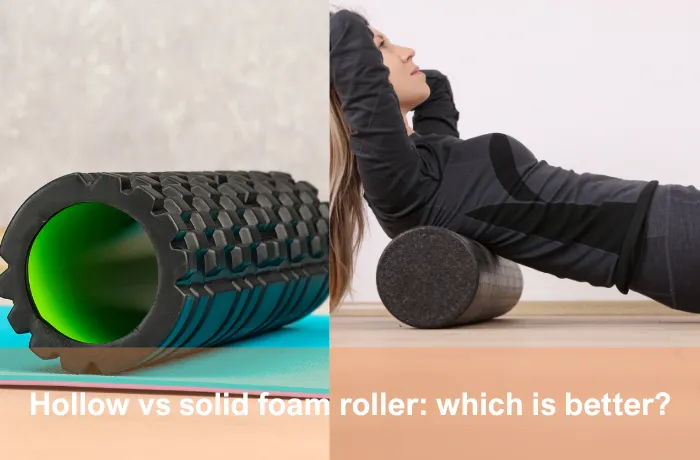The best yoga mat depends on how you practice. Yoga mats come in many types. Each type has its own good points. You may want a mat with extra grip for better balance. Some people like mats that are thicker for more comfort. Many people now want eco-friendly yoga mats. These mats use materials like natural rubber or cork. Some mats are easy to clean, which keeps them hygienic. Size and how easy it is to carry also matter. This is important if you travel a lot. A good yoga mat should feel nice, last long, and not cost too much. Think about what is most important to you before you pick a mat.
Key Takeaways
- Pick a yoga mat that matches your practice style. You may need more grip for hot yoga. You may want a thicker mat for restorative yoga.
- Choose a mat size that fits your height and yoga style. This helps you feel comfortable and gives you space to move.
- Try to find mats made from eco-friendly materials. Natural rubber or cork are good choices. These help the planet and give you good grip and comfort.
- Think about comfort and how easy it is to carry your mat. Pick a mat thickness and weight that fits your life and travel needs.
- Make a checklist before you buy a yoga mat. Think about grip, thickness, size, material, and how easy it is to clean.
Yoga Mats and Practice Types
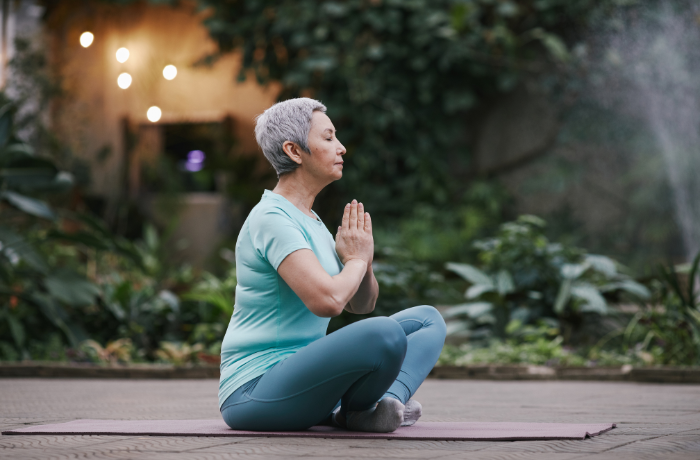
Hot Yoga
Hot yoga classes make you sweat a lot. You need a yoga mat that keeps you safe and steady. The best mats for hot yoga have a non-slip surface. This helps you keep your balance and avoid injuries, even when the mat gets wet. Mats made from TPE or natural rubber work well because they keep their grip when wet. Some mats, like the Jade Yoga Mat, offer excellent grip and are eco-friendly. You may also want to use a towel on top of your mat for extra grip and sweat control.
Tip: Always choose a mat that is easy to clean. Hot yoga mats collect sweat, so you want a mat that dries fast and does not hold bacteria.
Here is a table to help you see what features are ideal for hot yoga:
| Feature | Why It Matters for Hot Yoga |
|---|---|
| Non-Slip Surface | Prevents slipping when sweaty |
| Cushioning | Protects joints on hard floors |
| Durability | Handles frequent, sweaty workouts |
| Easy Maintenance | Quick cleaning stops bacteria buildup |
| Eco-Friendly | Natural rubber or non-toxic materials are safer |
| Grip When Wet | Keeps you stable during poses |
| Portability | Lightweight mats are easier to carry to class |
| No Stretch | Mat stays in place during movement |
| Affordability | Good value for quality and features |
You want a mat that does not stretch or slide on the floor. Mats with strong yoga mat grip are ideal for hot yoga. Avoid PVC mats because they can get slippery and may contain harmful chemicals.
Restorative Yoga
Restorative yoga focuses on gentle poses and long holds. You spend more time sitting or lying down. For this style, comfort is most important. Choose a mat with extra thickness, usually between 6mm and 9mm. This extra cushioning protects your joints and makes it easier to relax.
Mats made from cork, natural rubber, or soft foam work well for restorative yoga. These materials feel soft and support your body during long poses. Some people use a wool mat or layer two mats for even more comfort.
Note: Thicker mats may not be stable for balance poses, but they are perfect for gentle, relaxing workouts.
Vinyasa Yoga
Vinyasa yoga uses flowing movements and quick transitions. You need a mat that helps you move smoothly and keeps you steady. A mat with strong yoga mat grip and a textured surface works best. This stops you from slipping during fast poses.
For Vinyasa, a mat with medium thickness (about 4mm) gives you both comfort and stability. Thin mats (1-3mm) help you feel the floor and improve balance, but may not protect your joints as much. Large mats, at least 72 inches long and 24 inches wide, give you space to move.
- Choose mats made from natural rubber or TPE for better grip and durability.
- Eco-friendly mats support a mindful practice and help the planet.
A mat with the right grip and size helps you focus on your flow and enjoy your workout.
Travel Yoga
If you travel often or need a yoga mat for gym use, portability matters most. Travel yoga mats are thinner and lighter than standard mats. They fold or roll up easily to fit in your bag. Most travel mats use natural rubber or TPE for good yoga mat grip, even though they are thin.
Here is a quick comparison of popular travel yoga mats:
| Yoga Mat | Weight | Padding | Grip | Eco-friendliness | Notes |
|---|---|---|---|---|---|
| Manduka eKO SuperLite | Very Light | Low | High | High | Foldable, minimal padding, rubber odor |
| Jade Travel Yoga Mat | Light | Moderate | High | Very High | Eco-friendly, sticky texture |
| Liforme Travel Mat | Light | Moderate | High | Exceptional | Alignment markers, good padding |
| Gaiam Foldable Mat | Moderate | More | Good | Not specified | Heavier, sticky texture |
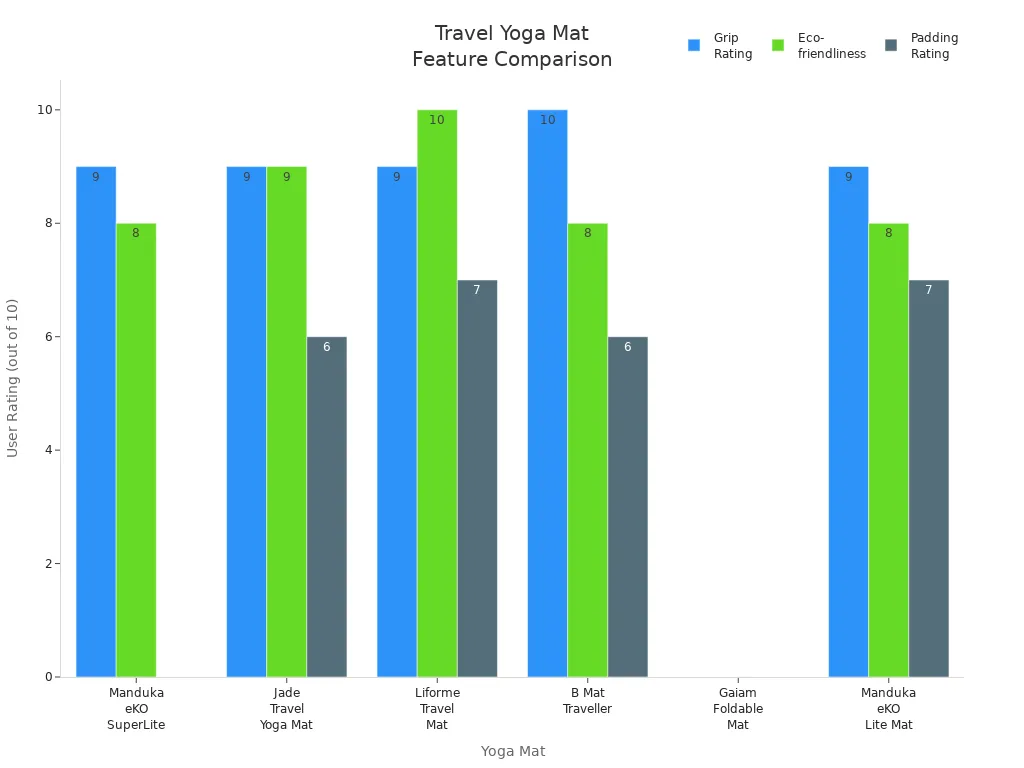
Travel mats may not have as much cushioning as regular mats. If you need more comfort, use a towel or blanket under your mat. These mats still offer good grip and last through many workouts if you care for them.
Beginners
If you are a beginner, you may not know what features you need yet. Try renting or borrowing different types of yoga mats before you buy one. Look for a mat with good grip to help you stay steady in standing and balance poses. A mat with medium thickness (about 5mm) gives you comfort for sitting and kneeling poses.
- Lightweight mats are easier to carry if you walk or take the bus.
- Mats that are easy to clean help you keep your mat fresh.
- Avoid very cheap mats because they can be slippery and wear out fast.
Common mistakes include picking a mat that is too thin for your joints or too thick for balance. Always check the mat’s length and width to make sure you fit comfortably.
Advanced Practice
If you have an advanced yoga practice, you need a mat that supports challenging poses and balance. Look for a mat that balances thickness and density. A dense mat gives you joint support but still lets you feel the floor. This helps you stay stable in hard poses.
Choose a mat with excellent yoga mat grip and a non-slip texture. Natural rubber mats are popular for advanced yogis because they are firm, elastic, and eco-friendly. Mats around 6mm thick with high density work well for advanced workouts, but avoid mats that are too thick because they can reduce your connection to the floor.
A mat with the right texture gives you feedback through your hands and feet. This helps you focus and stay safe during advanced poses.
A clean mat keeps its grip, so wash your mat often to keep it working well for your practice.
Best Yoga Mat Features
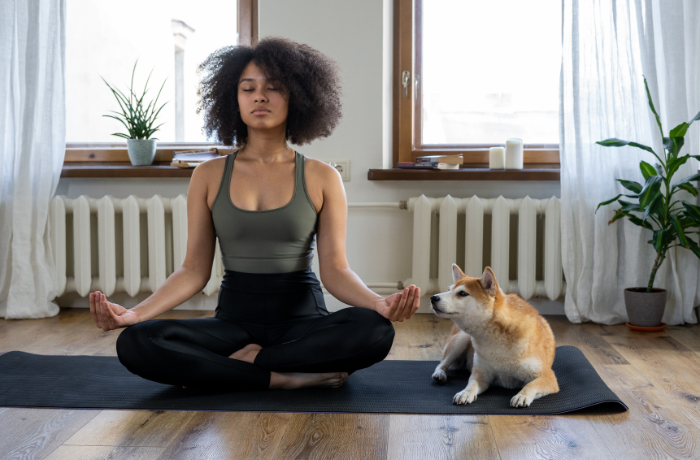
Material
There are many yoga mat materials you can pick from. Each one has good and bad sides. TPE mats are light, safe, and break down in nature. They have good yoga mat grip but might not last as long. PVC mats are strong and cost less money. They give great grip and are simple to clean, but they are not good for the earth. Natural rubber mats have strong yoga mat grip and feel comfy. They are better for the planet and break down over time, but some people are allergic to them. Cork mats stop germs from growing and have a firm grip, which is helpful for hot yoga. Jute and cotton mats are natural and let air pass through, but they do not give much support and take longer to dry.
| Material | Benefits | Drawbacks |
|---|---|---|
| TPE | Eco-friendly, lightweight, excellent grip | Less durable, wears down faster |
| PVC | Durable, affordable, great grip | Not environmentally friendly |
| Natural Rubber | Eco-friendly, biodegradable, excellent traction and cushioning | May cause allergies, more expensive |
| Jute | Natural, renewable, durable, breathable | Less cushioning, not ideal for sensitive joints |
| Cotton | Soft, absorbent, natural feel | Less support, takes longer to dry |
Thickness
How thick your yoga mat is changes how it feels. Thicker mats, about 5 to 7 mm, help protect your joints and feel softer. This is good for gentle yoga or if your knees hurt. But very thick mats can make it hard to balance because your hands and feet sink in. Standard mats, about 3 to 4 mm, give you both comfort and balance. Travel mats are thin, about 1 to 2 mm, and easy to carry, but they do not have much padding.
Tip: Pick a yoga mat thickness that fits your style and what feels best for you.
Grip
Yoga mat grip is super important for your safety. A mat with strong grip keeps you from slipping during poses. Mats made from natural rubber or TPE have better grip, especially when you sweat. Mats with bumpy surfaces or special coatings help too. If you do hot yoga, get a mat with extra grip to stay safe.
Size and Weight
How big and heavy your mat is changes how easy it is to use. Most mats are about 68 inches long and 24 inches wide. If you are tall, you might need a longer mat. Travel mats are lighter and thinner, so you can fold and pack them easily. Heavier mats stay in place better but are harder to carry.
Durability
How long your mat lasts depends on what it is made of. PVC mats can last 5 to 10 years. Natural rubber mats last 1 to 5 years. TPE mats last about 3 to 5 years. Cork, cotton, and jute mats can last a long time if you take care of them. If you use your mat a lot, pick a strong material so it lasts longer.
Eco-Friendly Options
Eco-friendly mats use materials that are better for the earth. These include natural rubber, cork, organic cotton, wool, jute, or hemp. These mats help protect the planet and break down over time. Look for labels like OEKO-TEX or GOTS to make sure your mat is safe for the environment.
Ideal Yoga Mat Size
Standard Sizes
When you start looking for a yoga mat, you will see many options. The standard yoga mat size is usually 68 inches long and 24 inches wide. This size fits most people and works well for many yoga styles. If you want to compare different sizes, a yoga mat size chart can help you see the differences. Most yoga mat size charts show that mats range from 68 to 84 inches in length and 24 to 36 inches in width. You can use a yoga mat size chart to check if a mat will fit your body and your practice space.
| Yoga Mat Size (inches) | Best For |
|---|---|
| 68 x 24 | Most adults under 6 ft |
| 72 x 24 | Taller adults |
| 80-84 x 24-36 | Very tall or broad |
Tip: Always check a yoga mat size chart before you buy. This helps you avoid mats that are too short or too narrow.
Choosing the Right Size
You want the ideal yoga mat size for your body and your practice. If you are taller than 6 feet, pick a mat that is at least 80 inches long. This keeps your whole body on the mat during poses like Savasana. If you have a broad frame or do styles like Iyengar or Acro Yoga, look for mats that are 30 inches wide or more. A yoga mat size chart can show you which mats give you extra space for props or partner work.
Your practice style also matters. Vinyasa and Ashtanga yoga need longer mats for flowing moves. Restorative and Yin yoga need wider mats for comfort and props. If you travel, a smaller mat is easier to carry, but always check the yoga mat size chart to make sure it still fits your needs.
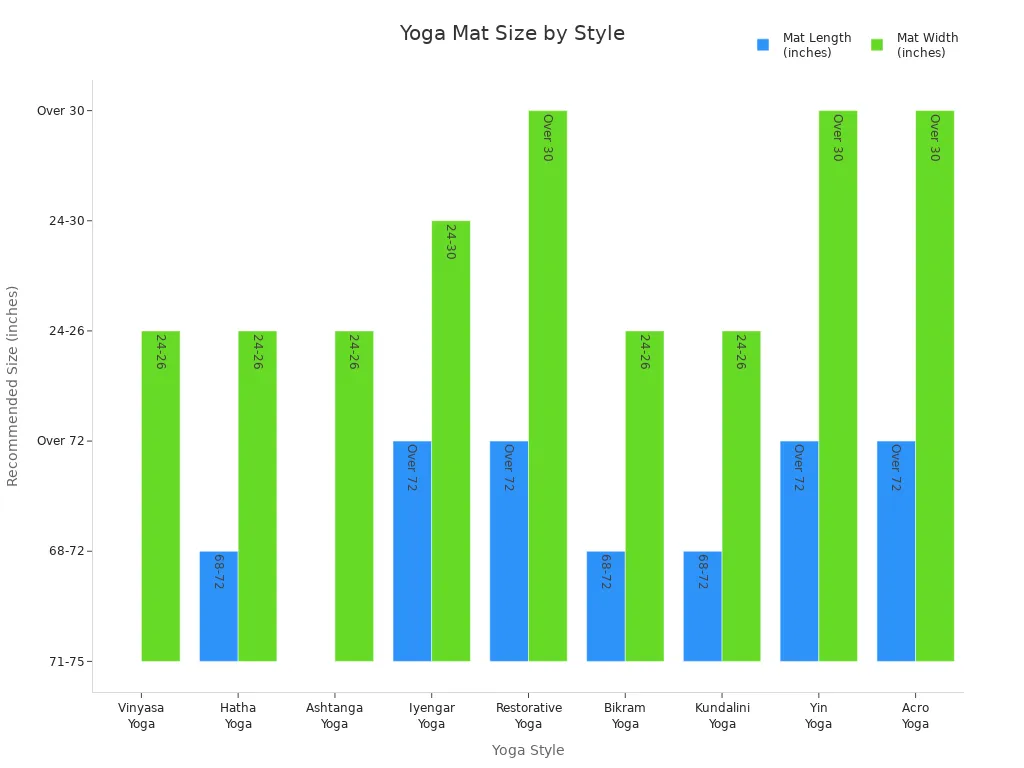
A good yoga mat size chart helps you match your height, practice, and comfort. The ideal yoga mat size gives you enough space to move, stretch, and relax without slipping off the mat.
Yoga Mat Guide for Your Needs
Assess Your Practice
Start by looking at your yoga habits. Think about how often you practice, what style you enjoy, and where you do yoga. If you sweat a lot or do hot yoga, you need a mat with strong grip and easy cleaning. If you have joint pain, look for extra thickness for more comfort. Here is a simple step-by-step yoga mat guide to help you:
- Decide your main yoga style and how often you practice.
- Check if you need extra cushioning for your joints.
- Pick a material that matches your needs, like natural rubber for grip or TPE for light weight.
- Choose the right size and thickness for your body and practice.
- Set a budget and think about long-term value.
- Test grip and texture if you can, or read reviews.
- Learn how to care for your mat to make it last.
Create a Mat Checklist
Use this checklist to find the best yoga mat for you:
- Measure your height and add a few inches for space.
- Match the mat thickness to your yoga style.
- Think about how much you travel with your mat.
- Choose a material that fits your comfort and eco needs.
- Avoid mats with PVC if you want a safer choice.
- Read reviews and try mats if possible.
- Set a budget for your mat.
- Check how easy it is to clean and store.
Tip: A good yoga mat should feel right for your body and support your practice every day.
Comfort vs. Portability
You need to balance comfort and portability. Thicker mats give more cushioning and protect your joints, but they are heavier and harder to carry. Thin mats are light and easy to pack, but they may not give enough support for long sessions. TPE mats offer a good mix of comfort and light weight. Natural rubber mats give great grip and padding, but they can be heavy. Think about your needs and choose the mat that fits your lifestyle best.
You want to find the best yoga mat for your practice and your needs. Use the guide and checklist to help you make a smart choice. Focus on comfort, stability, and what feels right for your body. Try different mats if you can or read reviews from other people. When you match your yoga mats to your style, you enjoy your practice more and stay safe.
FAQ
What is the best yoga mat for different practices?
Pick a yoga mat that matches your main practice. For hot yoga, you need a mat with strong yoga mat grip. Restorative yoga works best with a thick and comfy mat. If you travel, use a mat that is easy to carry. A yoga mat guide can help you compare different mats.
How do I choose the ideal yoga mat size?
Look at a yoga mat size chart before buying. Most people fit on a standard yoga mat size. Taller people should get a longer mat. The right yoga mat size gives you space and protects your joints. Always think about your height and how you practice.
Which materials are best for eco-friendliness and comfort?
Natural rubber mats and eco-friendly mats are good for the planet. These yoga mat materials feel soft and give support. Many people like these mats because they are eco-friendly. You can also try cork or jute mats if you want something different.
What thickness should a beginner or advanced user pick?
Beginners should pick a mat with more yoga mat thickness for comfort. Advanced users may want a thinner mat for better balance. Pick the thickness that helps your joints and fits your yoga style.

